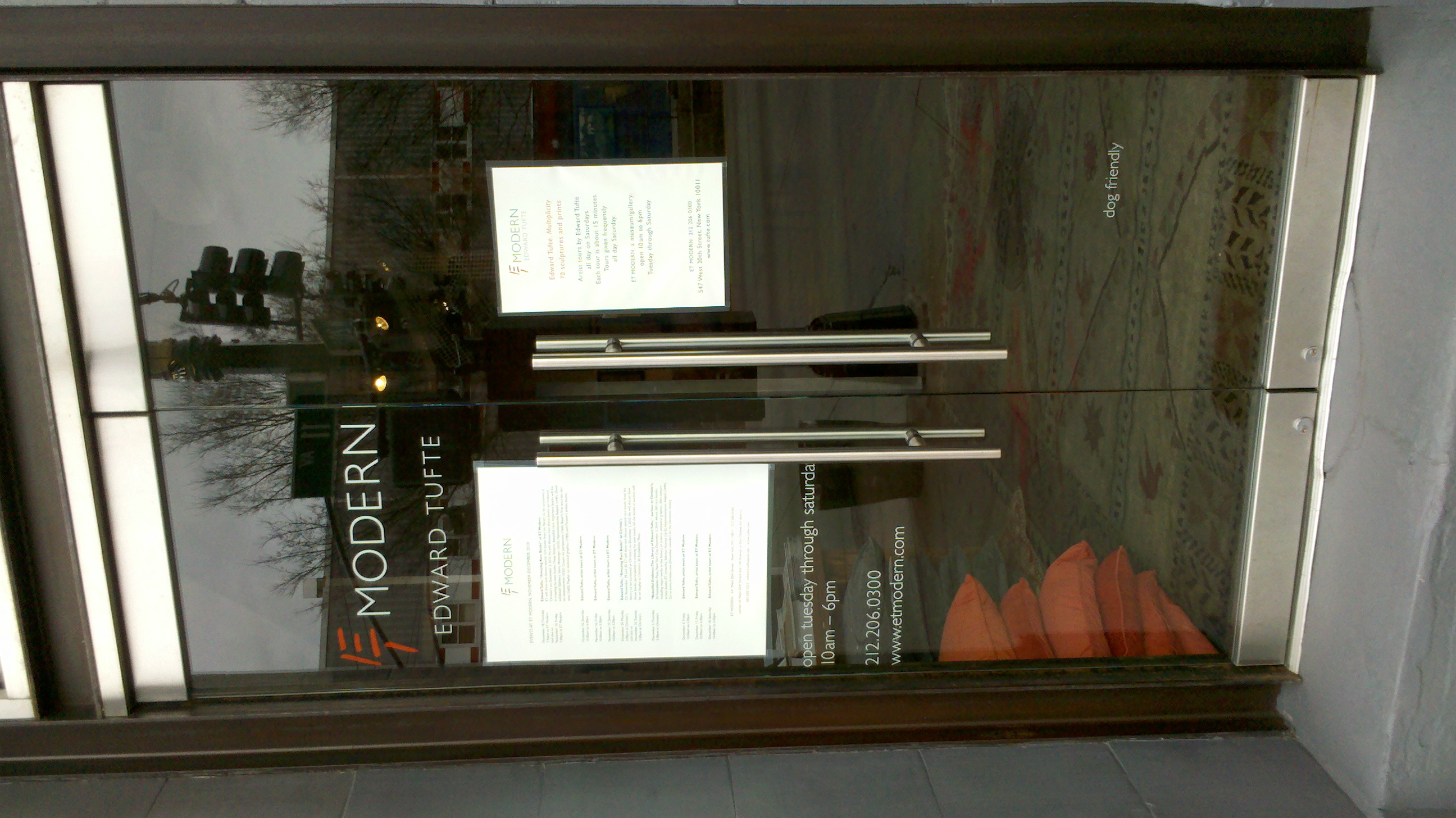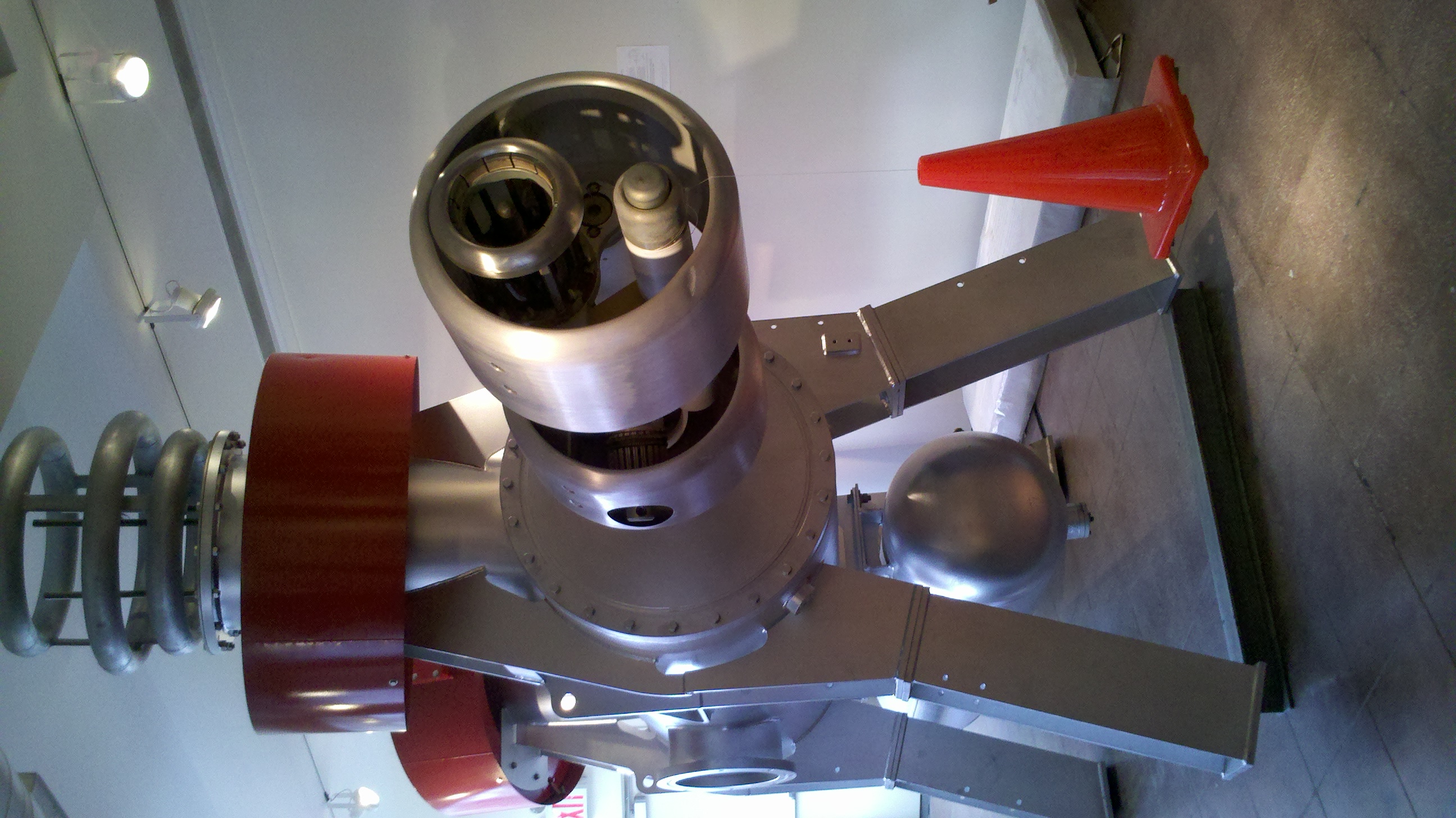Courtesy of a friend with a business meeting and a fancy airplane, I took a trip to New York City yesterday, starting with an 0530 wakeup and landing on runway 24 with winds from 310 gusting to 25 knots while a low-level wind shear advisory was in effect. Not fun and not pretty, but now I have verified that the landing gear is attached remarkably securely to the plane. The ramp in Teterboro was packed with Gulfstreams and mid-size jets and takeoffs and landings are brisk. They’re partying like it’s 2007. The drive into Manhattan took an hour, i.e., longer than the flight from Boston. Judging by the packed ramp at Teterboro and the horrible traffic through the Holland Tunnel, it seems that Wall Street is doing better than ever.
I met my friend Iris in Chelsea and we walked into a few art galleries, each one of which was presided over by a disdainful young woman typing at a computer who would barely look up as we entered. The experience at ET Modern is completely different. A freshly-filled dog water bowl out front welcomes canine guests, along with a “dog-friendly” sign on the glass door. Mahmood (sp?) greets every visitor and offers an essay designed to be helpful when looking at Edward Tufte’s sculptures. A clean public bathroom awaits those who’ve been crossing their legs at the other galleries in Chelsea. A lot of Tufte’s sculptures deserve to be seen as part of a beautiful landscape and in the ever-changing light of the outdoors, but the ET Modern gallery is a great place to get an introduction to Tufte’s sculpture and the smaller pieces can be appreciated fully here.
Three readers were kind enough to join us at the gallery and we proceeded to a local patisserie for lunch. We discussed an article from that day’s New York Times about an international comparison of 15-year-olds. Students in Shanghai were absurdly smarter than American kids. The standard American response to mediocre objective results from its K-12 schools is to say “Well, we have great universities.” One of the readers works in a company that produces a database management system, exactly the kind of systems programming challenge that computer science graduates are supposed to be good at. “We interview CS graduates from Columbia and they can’t solve the simplest interview problems, such ‘write a program to reverse a linked list'”. [in Lisp: “(reverse the-list)”] “Our company has ended up being mostly staffed by people who studied other subjects and were drawn to programming as a passion.” Note that Columbia now costs $57,000 per year (source). [Related: “What’s wrong with the standard undergraduate computer science curriculum”]
I met some cousins at the Metropolitan Museum and enjoyed “Our Future is in the Air”, photographs from 100 years ago. My favorites were of helicopters circa 1912. The big show is The World of Khubilai Khan, with some beautiful portraits done in silk tapestry. The Mongols were Buddhists and the show is heavy on Buddhist religious art that is not familiar to most Westerners (i.e., you’ll be intrigued or bored).
I had dinner with a man who considers himself a serious artist, a great composer and librettist whose works have been performed by the Chicago Symphony and orchestras throughout Europe. Also at the table was a literary novelist, whose works are best described as “like Kafka, but without the humor”; he claims to be attempting to expand the form of the novel itself, not merely aping Tolstoy. Also at the table was a Brazilian who has made her living dancing, acting, and modeling. She makes no claims for herself as an intellectual. When presented with a challenging family dynamics problem, however, the great intellectuals offered advice that ranged from incomprehensible to useless to insane. The dancer offered useful actionable advice.
We took a car ride back to the Hilton Hasbrouck Heights, where the interior design reminds you constantly that you’re in New Jersey. It has the advantage of being a three-minute ride from the Hilton to Teterboro, where we fired up this morning at 0900 and departed for Martha’s Vineyard to pick up a cancer patient (Angel Flight) and bring her back with us to Boston where she is getting treatment. Winds were gusting 25-30 knots everywhere, which made for a bumpy ride, but the plane went back into the hangar without anything bent.





Re absurdly smart Chinese:
http://bloodandtreasure.typepad.com/blood_treasure/2010/12/super-students.html
“Note that Columbia now costs $57,000 per year (source).”
Amazing, considering you can download computer books off of rapidshare (not that I endorse this) and learn to program for free, provided you’re passionate about it (which of course all the money in the world can’t buy).
Phil, I am curious to hear your opinion on the article below, also from the New York Times, that states that Chinese graduates have trouble finding jobs. Employers don’t want to hire them because they are pure test-takers with no practical skills (practically the same kind of criticism you bestow on US graduates from top schools — and in the US, these are likely to be precisely those whose test scores were good):
http://www.nytimes.com/roomfordebate/2010/12/02/what-is-a-college-degree-worth-in-china/high-test-scores-low-ability
I have heard similar concerns about India, for instance — from friends who lived and went to a non-IIT university there.
Murali: Thanks for the link. The article you reference is consistent with the lackluster performance of Columbia graduates, i.e., a person can sit through lectures for four years, take some tests, get a degree, and yet remain clueless. From my experience visiting universities worldwide, including in India and China, I haven’t seen much evidence that foreign schools are much better than U.S. schools. On the other hand, they cost 1/10th as much to run.
The folks who run Chinese universities would probably respond to the criticism by pointing to the impressive accomplishments of their graduates (a time-honored technique here in the U.S.; schools take credit for stuff that parents taught the kids and/or that kids learned on their own). The economy is growing at 10 percent per year, they are able to complete massive projects, such as the new Beijing airport terminal (third largest building in the world says http://en.wikipedia.org/wiki/Beijing_Capital_International_Airport ), and the Chinese produce a lot of innovative products.
Let’s also look at where companies are choosing to invest. If the Chinese university graduates were as dumb as the nytimes article says, profit-minded businesses would set up offices in Detroit instead of Shanghai.
$57,000 per year is a lot of money. A few salary survey sites show that the salary of the average professor is only twice that:
http://www1.salary.com/Professor-Computer-Science-Salary.html
Somewhere out there is a teaching model of a small school with a average class size of <10 students. Perhaps as a sort of "Cram School" or "Prep School" model where 1 year allows a student to skip 2 years at the real university.
Of course if you want to do distance learning with an English speaking expert from a cheaper country the class sizes could be further reduced.
I am a professor affiliated with an analog electronics research center at a small public (state) university. Our students and postdocs learn to design, simulate, and test innovative electronic circuits. This is not the type of thing parents can teach their kids or kids can learn on their own. Math and physics background is a prerequisite, as well as a degree of creativity. I don’t know about computer science, but our students don’t get their degrees unless their circuits work to within pre-determined design tolerances.
Our center gets a lot of semiconductor industry funding, so part of my job is to keep in touch with our industrial sponsors. Even in the current economic climate, the consistent message I get from industry folks is “We have jobs open for any graduate from the center that you tell us is decent.” These are good, high-paying, high-value-added career engineering positions they are talking about.
Anyway, roughly 75% of our students and postdocs are Asian nationals [mostly Chinese, with Koreans and Japanese as well]. Another 15% are Indian nationals. 10% are US citizens (mostly Caucasian). Gender-wise, we are 90% male. We don’t target such an ethnic or gender distribution; it is just a reasonable reflection of the applicant pool. Most of the Asian and Indian nationals from our center graduate and go to work for US-headquartered semiconductor technology companies, though they may be assigned to a location outside the US. In recent years, though, we see more and more deciding to pursue their fortunes back in their home nation.
Markl: “pre-determined design tolerances” — it would be nice if commercial software worked within some tolerances, much less student efforts! Software engineering is something that is very badly taught at most schools, partly because the faculty are seldom themselves expert software engineers (in contrast to EE where there are a lot of great circuit designers at universities). So the undergrad program tends to define “computer science” as something that has nothing to do with ability to program, e.g., concentrate on complexity analysis of algorithms. This is why Columbia-educated CS graduates have to compete with self-taught programmers while probably Columbia-educated EE graduates do not have to compete with self-taught circuit designers.
Markl: What percentage of your qualified American applicants have immigrant parents and/or a parent with math/sci/eng training?
My anecdata from top programs indicates 100%..